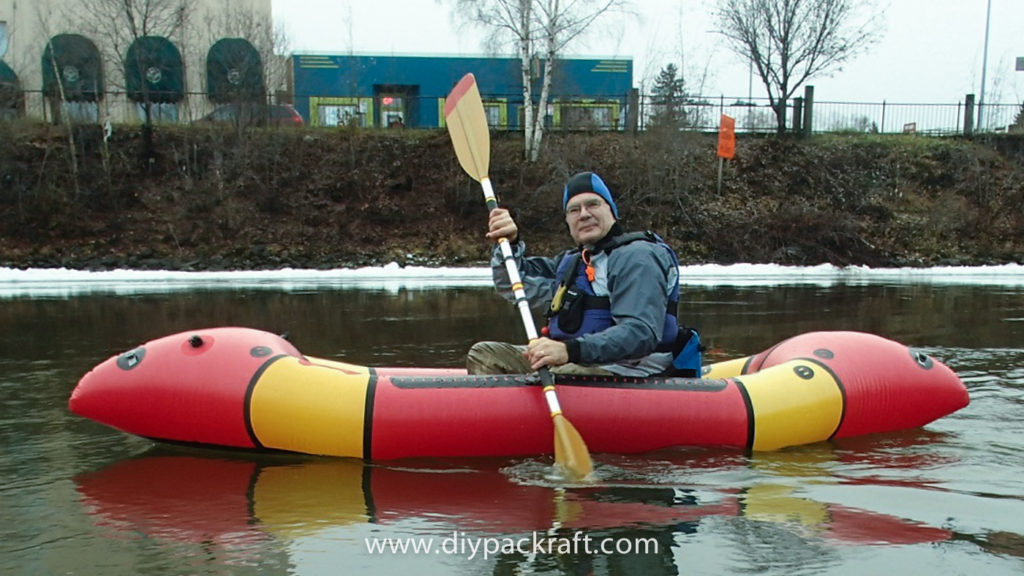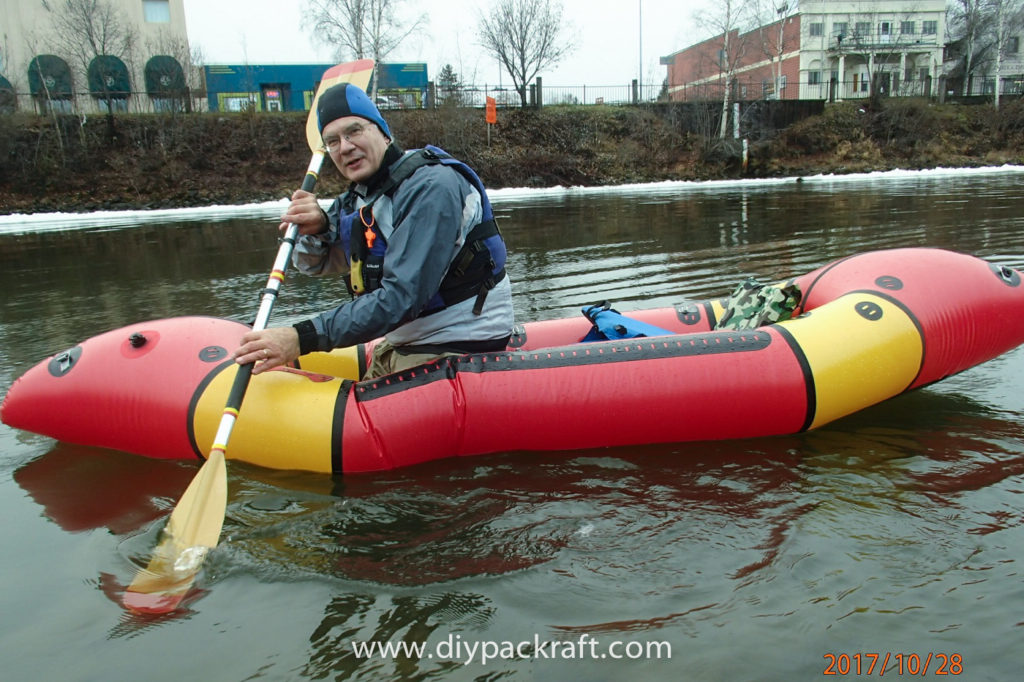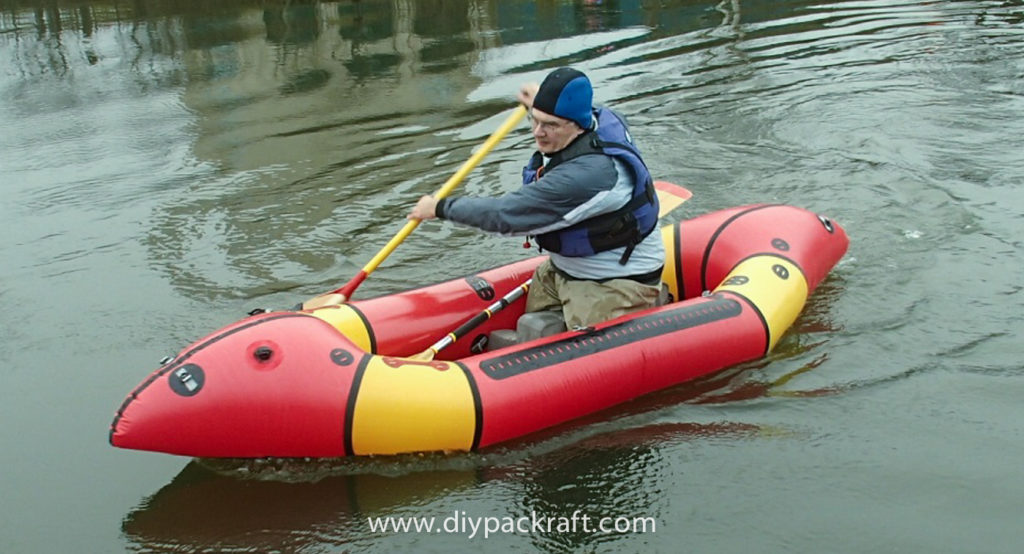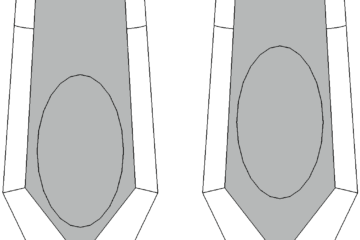Bruce C., a frequent contributor to the DIY Packraft forum and host of the popular DIY Packraft-making classes at the Folk School in Fairbanks, Alaska, has just finished this beautiful Voyageur 2-person DIY Packraft, and I just had to share these pictures he sent of its maiden voyage! Notice the snow in the background – Bruce had to clear a path through the shore ice before launching!
Bruce built this one from the Voyageur plans, and he used 210D fabric for the tubes and 1000D for the floor – total weight is just 8 1/4 pounds, or about 3.75 kg. It looks great with the airtight zipper and lots of attachment points installed (check out Bruce’s post in the Forum about his improved tie-down design).

Paddling it like a kayak – Bruce says it’s most comfortable sitting on a seat that raises him up about 10″ (25 cm) above the floor. Notice how there’s plenty of freeboard! (Photo credit: Bruce’s paddling partner)

Notice how kneeling without something on the floor to distribute one’s weight causes the tube to buckle when reaching forward for a paddle stroke. (Photo credit: Bruce’s paddling partner)
Here’s Bruce’s report, with minor editing by me:
The tandem is a very stable, wide craft. I was most comfortable sitting on about 10″ of seat cushions. I can understand why so many packrafters seek higher seats to improve their paddle stroke. Sitting deeper in the raft requires reaching out and over the tubes for each stroke, which is a lot more work! The raft is so light it is hard to compare to any other craft. There is no inertia, no delay in a paddle correction or turn, it is extremely responsive.
The raft felt stiff, but the cold water made it difficult to keep the raft fully inflated. In the second photo one can see the flex in the raft tube when I slide forward onto my knees and lean into the front of the raft.
I added a foam saddle to paddle it like a canoe. I could see adding a stiff plastic sheet under the seat (like an old Dagger solo canoe seat) to protect my knees before I considered paddling whitewater and risk hitting my knees on a rock. Otherwise it paddles like a short 9′ solo canoe. (I would put the zipper on the stern if I thought I was ever going to canoe the craft, as it is too easy to bump during a cross stroke.
Construction time: I spent more than two weeks building outfitting parts and attaching them to the panels. Assembling the raft only took about 5 days. I would modify the location of some of the outfitting if I build a second raft – it was really hard to estimate where the attachment points would be before it was inflated.
The heavy duty floor has the feel of the black hypalon NRS uses on the bottoms of their rafts except it is slicker, less grabby on rocks, (a good thing). The tandem is 11 feet long and 3′ wide, with an inside length of 6′. It weighs in at 8 1/4 lbs. on my old postal scale. The sides are parallel and the ends are symmetric.
To do: I will add an inflatable floor to further stiffen the raft, plus inflatable seats, both of which will tie into tabs I fashioned along the floor. Depending on how the floor works out, I will consider making it into a self bailing raft.
Thanks for sending that, Bruce!
Voyageur 2-Person DIY Packraft kits are available for pre-order now, and I plan to start shipping them in November.


8 Comments
SnorbertZangox · May 15, 2019 at 7:46 pm
Thinking of trying to replicate this. How much of a problem was banging knees in WW (I usually wear knee pads for OC1 anyway. How hard to add self bailing floor?
I love the packraft idea, but can’t sit for extended period.
Dadbod · July 4, 2018 at 11:41 am
I love this idea, but I don’t like the pointed bow. I would think you’d want a high-volume, rockered now to get the long boat up and over waves. (I’m a WW canoeist, and I love Blackfly boats like the Ion or Octane. Both have blunt, high-volume bows that make those canoes the driest boats I’ve ever paddled.) Do you think it’d be possible to have a tube at the front that is perpendicular to the boat centerline, and lifted a little to provide some rocker? I imagine a slightly wider bow might increase stability a little.
Kent Griswold · November 22, 2017 at 8:44 am
Would this be considered harder to build than the standard size for a first time boat builder? My wife is not sure about going alone so I have considered a double. The other option is build a regular one and get her confidence up and then build a second.
Matt (Admin) · November 22, 2017 at 8:48 am
Hi Kent, the construction method is the same as for the single V3 kits, so there’s not really any difference in difficulty – the seams are longer though so it might take a bit more time. Cheers!
Kent · November 22, 2017 at 10:12 am
Thanks, Matt, I may go with the larger boat to start with then as I think we could have a lot of fun together with it. Now to figure out the finances and get this project together so I can have it ready for exploring the lakes here in central Oregon when returns! So happy to have discovered you as Alpacka’s Gnu just was out of my reach…
Matt (Admin) · November 22, 2017 at 2:09 pm
Excellent!
James · October 31, 2017 at 9:18 pm
The thing along the side of the packraft looks like adjustable points for tie downs? Is that correct and if so any idea how they were done?
Matt (Admin) · November 1, 2017 at 8:30 am
That’s correct – I believe they’re made out of the 1000D and 210D fabric with holes punched through, and they were heat sealed to the tube from the inside, before putting the packraft together. Cheers!